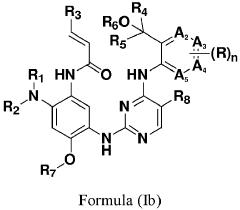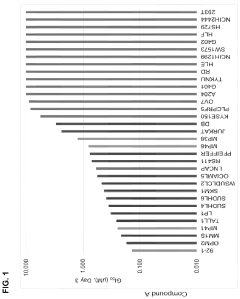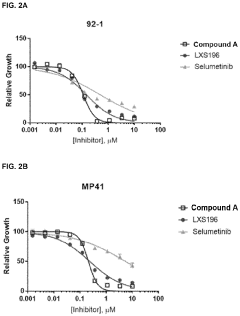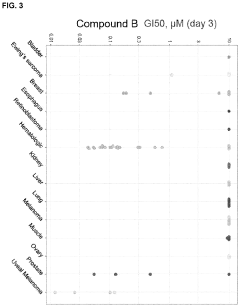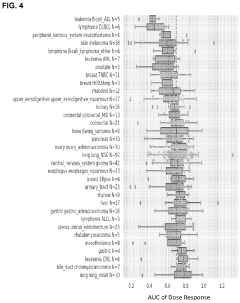The Role of Geometric Isomers in Biological Pathway Modulation
AUG 1, 20259 MIN READ
Generate Your Research Report Instantly with AI Agent
Patsnap Eureka helps you evaluate technical feasibility & market potential.
Geometric Isomers Background
Geometric isomers, also known as spatial isomers, are molecules with the same molecular formula but different spatial arrangements of atoms. These isomers play a crucial role in various biological processes, including pathway modulation. The concept of geometric isomerism dates back to the 19th century when scientists first observed differences in the properties of compounds with identical molecular formulas.
In the context of biological pathway modulation, geometric isomers have gained significant attention due to their ability to interact differently with cellular components, leading to diverse biological responses. This phenomenon is particularly important in drug discovery and development, where the spatial arrangement of atoms can dramatically affect a compound's efficacy and safety profile.
The importance of geometric isomers in biological systems stems from the fact that many biomolecules, such as proteins and enzymes, have specific three-dimensional structures. These structures are often complementary to the spatial arrangement of their substrates or ligands. As a result, even slight changes in the geometric configuration of a molecule can lead to significant alterations in its biological activity.
One of the most well-known examples of geometric isomerism in biology is the cis-trans isomerism of unsaturated fatty acids. The cis configuration, which is more common in nature, results in a bent shape of the fatty acid chain, while the trans configuration leads to a straighter chain. This difference in geometry has profound implications for membrane fluidity and cellular function.
In the field of pharmacology, geometric isomers have been extensively studied for their differential effects on drug-target interactions. Many drugs exist as geometric isomers, and often only one isomer is responsible for the desired therapeutic effect, while the other may be inactive or even harmful. This understanding has led to the development of stereospecific synthesis techniques and the production of single-isomer drugs.
The study of geometric isomers in biological pathway modulation has been greatly facilitated by advances in analytical techniques, such as X-ray crystallography and nuclear magnetic resonance (NMR) spectroscopy. These methods allow researchers to determine the precise spatial arrangements of atoms within molecules and study their interactions with biological targets.
As our understanding of the role of geometric isomers in biological systems continues to grow, new opportunities for targeted drug design and pathway modulation emerge. Researchers are now exploring the potential of geometric isomerism to develop more effective and selective therapeutic agents, as well as to gain deeper insights into the fundamental mechanisms of cellular processes.
In the context of biological pathway modulation, geometric isomers have gained significant attention due to their ability to interact differently with cellular components, leading to diverse biological responses. This phenomenon is particularly important in drug discovery and development, where the spatial arrangement of atoms can dramatically affect a compound's efficacy and safety profile.
The importance of geometric isomers in biological systems stems from the fact that many biomolecules, such as proteins and enzymes, have specific three-dimensional structures. These structures are often complementary to the spatial arrangement of their substrates or ligands. As a result, even slight changes in the geometric configuration of a molecule can lead to significant alterations in its biological activity.
One of the most well-known examples of geometric isomerism in biology is the cis-trans isomerism of unsaturated fatty acids. The cis configuration, which is more common in nature, results in a bent shape of the fatty acid chain, while the trans configuration leads to a straighter chain. This difference in geometry has profound implications for membrane fluidity and cellular function.
In the field of pharmacology, geometric isomers have been extensively studied for their differential effects on drug-target interactions. Many drugs exist as geometric isomers, and often only one isomer is responsible for the desired therapeutic effect, while the other may be inactive or even harmful. This understanding has led to the development of stereospecific synthesis techniques and the production of single-isomer drugs.
The study of geometric isomers in biological pathway modulation has been greatly facilitated by advances in analytical techniques, such as X-ray crystallography and nuclear magnetic resonance (NMR) spectroscopy. These methods allow researchers to determine the precise spatial arrangements of atoms within molecules and study their interactions with biological targets.
As our understanding of the role of geometric isomers in biological systems continues to grow, new opportunities for targeted drug design and pathway modulation emerge. Researchers are now exploring the potential of geometric isomerism to develop more effective and selective therapeutic agents, as well as to gain deeper insights into the fundamental mechanisms of cellular processes.
Market Analysis
The market for geometric isomers in biological pathway modulation is experiencing significant growth, driven by increasing research in drug discovery and development. This field has garnered substantial attention from pharmaceutical companies, biotechnology firms, and academic institutions due to its potential to revolutionize therapeutic approaches.
The global market for geometric isomer-based drugs and research tools is expanding rapidly. This growth is primarily fueled by the rising prevalence of chronic diseases and the need for more effective, targeted therapies. The ability of geometric isomers to modulate biological pathways with high specificity makes them attractive candidates for developing novel drugs with improved efficacy and reduced side effects.
In the pharmaceutical sector, geometric isomers are being extensively explored for their potential in treating various diseases, including cancer, cardiovascular disorders, and neurological conditions. The market for cancer therapeutics, in particular, has shown keen interest in geometric isomer-based approaches, as they offer new avenues for targeting specific molecular pathways involved in tumor growth and progression.
The research tools market associated with geometric isomers is also expanding. This includes analytical instruments, software for molecular modeling, and specialized reagents for studying isomeric interactions in biological systems. These tools are essential for both academic research and industrial drug discovery processes, contributing to the overall market growth.
Geographically, North America and Europe lead the market due to their advanced research infrastructure and high investment in pharmaceutical R&D. However, Asia-Pacific is emerging as a rapidly growing market, driven by increasing research activities in countries like China, Japan, and India.
The market is characterized by collaborations between academic institutions and pharmaceutical companies, aiming to translate fundamental research into clinical applications. This trend is expected to accelerate the development of geometric isomer-based therapies and drive market expansion.
Despite the promising outlook, challenges such as complex regulatory pathways for isomer-specific drugs and the high costs associated with research and development may impact market growth. However, the potential benefits of geometric isomer-based therapies in terms of improved patient outcomes and reduced healthcare costs are likely to outweigh these challenges in the long term.
As the understanding of geometric isomers in biological pathways deepens, the market is expected to witness the emergence of personalized medicine approaches, where specific isomeric forms of drugs are tailored to individual patient profiles. This trend aligns with the broader shift towards precision medicine in the healthcare industry.
The global market for geometric isomer-based drugs and research tools is expanding rapidly. This growth is primarily fueled by the rising prevalence of chronic diseases and the need for more effective, targeted therapies. The ability of geometric isomers to modulate biological pathways with high specificity makes them attractive candidates for developing novel drugs with improved efficacy and reduced side effects.
In the pharmaceutical sector, geometric isomers are being extensively explored for their potential in treating various diseases, including cancer, cardiovascular disorders, and neurological conditions. The market for cancer therapeutics, in particular, has shown keen interest in geometric isomer-based approaches, as they offer new avenues for targeting specific molecular pathways involved in tumor growth and progression.
The research tools market associated with geometric isomers is also expanding. This includes analytical instruments, software for molecular modeling, and specialized reagents for studying isomeric interactions in biological systems. These tools are essential for both academic research and industrial drug discovery processes, contributing to the overall market growth.
Geographically, North America and Europe lead the market due to their advanced research infrastructure and high investment in pharmaceutical R&D. However, Asia-Pacific is emerging as a rapidly growing market, driven by increasing research activities in countries like China, Japan, and India.
The market is characterized by collaborations between academic institutions and pharmaceutical companies, aiming to translate fundamental research into clinical applications. This trend is expected to accelerate the development of geometric isomer-based therapies and drive market expansion.
Despite the promising outlook, challenges such as complex regulatory pathways for isomer-specific drugs and the high costs associated with research and development may impact market growth. However, the potential benefits of geometric isomer-based therapies in terms of improved patient outcomes and reduced healthcare costs are likely to outweigh these challenges in the long term.
As the understanding of geometric isomers in biological pathways deepens, the market is expected to witness the emergence of personalized medicine approaches, where specific isomeric forms of drugs are tailored to individual patient profiles. This trend aligns with the broader shift towards precision medicine in the healthcare industry.
Current Challenges
The field of geometric isomers in biological pathway modulation faces several significant challenges that hinder its full potential in drug discovery and therapeutic applications. One of the primary obstacles is the complexity of biological systems and the intricate interplay between geometric isomers and their target molecules. The spatial arrangement of atoms in these isomers can dramatically affect their binding affinity and specificity, making it difficult to predict and control their biological activities.
Another major challenge lies in the synthesis and purification of specific geometric isomers. Many compounds exist as mixtures of different isomers, and separating them into pure forms can be technically demanding and costly. This difficulty in isolation often leads to the use of racemic mixtures in research and drug development, potentially masking the true efficacy or side effects of individual isomers.
The dynamic nature of biological systems presents yet another hurdle. Geometric isomers can interconvert under physiological conditions, complicating the understanding of their precise roles in pathway modulation. This interconversion can lead to unexpected biological responses and make it challenging to maintain a consistent therapeutic effect over time.
Furthermore, the lack of comprehensive databases and predictive models for geometric isomer interactions in biological pathways impedes rapid progress in this field. While computational methods have advanced significantly, accurately simulating the behavior of geometric isomers in complex biological environments remains a formidable task.
The regulatory landscape also poses challenges for the development of geometric isomer-based therapeutics. Stringent requirements for demonstrating the safety and efficacy of individual isomers, as well as their mixtures, can significantly increase the time and cost of bringing new treatments to market.
Lastly, the field faces a knowledge gap in understanding the long-term effects of modulating biological pathways through geometric isomers. The potential for unintended consequences in complex biological networks necessitates extensive longitudinal studies, which are both time-consuming and resource-intensive.
Addressing these challenges requires a multidisciplinary approach, combining advances in synthetic chemistry, analytical techniques, computational modeling, and systems biology. Overcoming these hurdles will be crucial for unlocking the full potential of geometric isomers in biological pathway modulation and their applications in medicine and biotechnology.
Another major challenge lies in the synthesis and purification of specific geometric isomers. Many compounds exist as mixtures of different isomers, and separating them into pure forms can be technically demanding and costly. This difficulty in isolation often leads to the use of racemic mixtures in research and drug development, potentially masking the true efficacy or side effects of individual isomers.
The dynamic nature of biological systems presents yet another hurdle. Geometric isomers can interconvert under physiological conditions, complicating the understanding of their precise roles in pathway modulation. This interconversion can lead to unexpected biological responses and make it challenging to maintain a consistent therapeutic effect over time.
Furthermore, the lack of comprehensive databases and predictive models for geometric isomer interactions in biological pathways impedes rapid progress in this field. While computational methods have advanced significantly, accurately simulating the behavior of geometric isomers in complex biological environments remains a formidable task.
The regulatory landscape also poses challenges for the development of geometric isomer-based therapeutics. Stringent requirements for demonstrating the safety and efficacy of individual isomers, as well as their mixtures, can significantly increase the time and cost of bringing new treatments to market.
Lastly, the field faces a knowledge gap in understanding the long-term effects of modulating biological pathways through geometric isomers. The potential for unintended consequences in complex biological networks necessitates extensive longitudinal studies, which are both time-consuming and resource-intensive.
Addressing these challenges requires a multidisciplinary approach, combining advances in synthetic chemistry, analytical techniques, computational modeling, and systems biology. Overcoming these hurdles will be crucial for unlocking the full potential of geometric isomers in biological pathway modulation and their applications in medicine and biotechnology.
Existing Modulation Methods
01 Geometric isomers in drug development
Geometric isomers play a crucial role in drug development, as they can exhibit different biological activities and pharmacological properties. Understanding the relationship between geometric isomerism and biological pathway modulation is essential for designing more effective and targeted therapeutics. Researchers investigate how different geometric configurations of molecules can affect their interactions with biological targets and influence various cellular processes.- Geometric isomers in drug development: Geometric isomers play a crucial role in drug development, as they can exhibit different biological activities and pharmacological properties. Understanding and controlling the geometric isomerism of drug molecules can lead to more effective and targeted therapies. This approach involves studying the spatial arrangement of atoms in molecules and how it affects their interaction with biological pathways.
- Biological pathway modulation using geometric isomers: Geometric isomers can be used to modulate biological pathways by selectively interacting with specific targets. This approach allows for fine-tuning of cellular processes and signaling cascades. By designing and synthesizing geometric isomers with desired properties, researchers can develop compounds that effectively modulate biological pathways for therapeutic purposes.
- Analytical methods for geometric isomer characterization: Advanced analytical techniques are employed to characterize and differentiate geometric isomers in complex biological systems. These methods include spectroscopic techniques, chromatography, and computational modeling. Accurate identification and quantification of geometric isomers are essential for understanding their effects on biological pathways and developing targeted interventions.
- Geometric isomers in metabolic pathway regulation: Geometric isomers can influence metabolic pathways by interacting with enzymes, receptors, and other cellular components. This property is exploited in the development of metabolic regulators and therapeutic agents. By designing geometric isomers that target specific metabolic pathways, researchers can modulate cellular metabolism for various applications, including treatment of metabolic disorders.
- Geometric isomers in signal transduction modulation: The spatial arrangement of atoms in geometric isomers can significantly impact their ability to interact with signaling molecules and receptors. This property is utilized to develop compounds that can modulate signal transduction pathways. By designing geometric isomers with specific conformations, researchers can target and regulate various cellular signaling processes for therapeutic interventions.
02 Biological pathway analysis using geometric isomers
Researchers utilize geometric isomers as tools to study and analyze biological pathways. By comparing the effects of different isomers on specific pathways, scientists can gain insights into the structure-activity relationships and mechanisms of action. This approach helps in identifying key molecular features responsible for modulating biological processes and can lead to the development of more precise pathway modulators.Expand Specific Solutions03 Geometric isomer-based pathway modulation in cancer research
Geometric isomers are explored for their potential in modulating biological pathways involved in cancer progression. Researchers investigate how different isomeric forms of compounds can selectively target cancer-related pathways, potentially leading to more effective and less toxic cancer treatments. This approach involves studying the effects of geometric isomers on cell signaling, apoptosis, and other cancer-related processes.Expand Specific Solutions04 Computational modeling of geometric isomers for pathway prediction
Advanced computational techniques are employed to model and predict the effects of geometric isomers on biological pathways. These in silico approaches help researchers to screen large numbers of isomeric compounds and predict their potential pathway modulation effects. This computational strategy accelerates the drug discovery process by identifying promising candidates for further experimental validation.Expand Specific Solutions05 Geometric isomers in metabolic pathway regulation
The role of geometric isomers in regulating metabolic pathways is an area of active research. Scientists investigate how different isomeric forms of metabolites or regulatory molecules can influence enzyme activity, metabolic flux, and overall cellular metabolism. This research has implications for understanding and potentially treating metabolic disorders by targeting specific isomeric forms of key regulatory molecules.Expand Specific Solutions
Key Industry Players
The field of geometric isomers in biological pathway modulation is in a nascent stage of development, with significant potential for growth. The market size is expanding as researchers recognize the importance of isomeric structures in drug design and biological processes. While the technology is still evolving, companies like Ionis Pharmaceuticals, AbbVie, and Vertex Pharmaceuticals are at the forefront, leveraging their expertise in molecular design and drug development. The competitive landscape is characterized by a mix of established pharmaceutical giants and specialized biotech firms, each bringing unique capabilities to address the complexities of geometric isomerism in biological systems. As the field matures, we can expect increased collaboration and innovation, driving advancements in targeted therapies and precision medicine.
AbbVie, Inc.
Technical Solution: AbbVie has developed a novel approach to modulating biological pathways through geometric isomers. Their research focuses on the design and synthesis of small molecule inhibitors that exploit the spatial arrangements of geometric isomers to achieve selective targeting of specific protein conformations[1]. This strategy has been particularly successful in developing inhibitors for kinases and other enzymes involved in cell signaling pathways. AbbVie's platform combines high-throughput screening with advanced computational modeling to identify compounds that can adopt different geometric isomeric forms, allowing for fine-tuned control over target engagement[3]. The company has also invested in developing proprietary chemical libraries enriched with compounds capable of geometric isomerization, enhancing their ability to discover potent and selective modulators of biological pathways[5].
Strengths: Highly selective targeting of protein conformations, potential for reduced off-target effects. Weaknesses: Complexity in manufacturing processes for geometrically pure compounds, potential for in vivo isomerization affecting drug efficacy.
Vertex Pharmaceuticals, Inc.
Technical Solution: Vertex Pharmaceuticals has pioneered the use of geometric isomers in the development of cystic fibrosis transmembrane conductance regulator (CFTR) modulators. Their approach leverages the distinct spatial arrangements of geometric isomers to optimize interactions with the CFTR protein[2]. By carefully designing compounds that can adopt specific geometric configurations, Vertex has created a series of potent CFTR correctors and potentiators. The company's platform integrates structure-based drug design with advanced synthetic chemistry techniques to control the geometric isomerism of their lead compounds[4]. This has resulted in the development of combination therapies that address multiple aspects of CFTR dysfunction, significantly improving outcomes for cystic fibrosis patients[6]. Vertex continues to explore the potential of geometric isomers in modulating other challenging targets in rare diseases and beyond.
Strengths: Proven success in developing clinically effective therapies, strong intellectual property position. Weaknesses: Narrow focus on specific disease areas, potential for high development costs due to complex chemistry.
Innovative Isomer Studies
Erbb/BTK inhibitors
PatentPendingEP4356975A2
Innovation
- Development of compounds represented by Formula (I) and its pharmaceutically acceptable salts, esters, hydrates, and stereoisomers, which are used in pharmaceutical compositions to inhibit ErbB family kinases and BTK, particularly targeting mutant forms to enhance therapeutic efficacy.
Compounds and uses thereof
PatentPendingUS20230145003A1
Innovation
- Development of specific compounds that modulate the BAF complex by inhibiting BRG1 and/or BRM activity, which can be used alone or in combination with other pharmaceutically active agents to treat disorders like cancer.
Regulatory Considerations
The regulatory landscape surrounding geometric isomers in biological pathway modulation is complex and multifaceted, requiring careful consideration from pharmaceutical companies, researchers, and regulatory bodies. The U.S. Food and Drug Administration (FDA) and the European Medicines Agency (EMA) have established specific guidelines for the development and approval of drugs involving geometric isomers.
These regulatory bodies emphasize the importance of thorough characterization and control of geometric isomers throughout the drug development process. Manufacturers must demonstrate the ability to consistently produce the desired isomeric form and maintain its stability throughout the product's shelf life. This often involves developing robust analytical methods to detect and quantify different isomeric forms.
Safety and efficacy considerations are paramount in the regulatory framework. Sponsors must provide comprehensive data on the pharmacological and toxicological profiles of individual geometric isomers, as well as their mixtures. This includes evaluating potential differences in absorption, distribution, metabolism, and excretion (ADME) properties between isomers.
Regulatory agencies also require sponsors to justify the selection of a specific isomeric form or mixture for development. This justification should be based on scientific evidence demonstrating superior efficacy, improved safety profile, or other clinically relevant advantages. In cases where a racemic mixture is proposed, sponsors must provide a rationale for not developing a single isomer product.
The regulatory pathway for geometric isomer-based drugs may involve additional clinical studies to assess the impact of isomeric composition on therapeutic outcomes. This could include comparative studies between different isomeric forms or evaluations of potential drug-drug interactions specific to certain isomers.
Labeling requirements for drugs containing geometric isomers are another crucial regulatory consideration. Product labels must clearly indicate the isomeric composition and any relevant information on the pharmacological differences between isomers. This ensures that healthcare providers and patients are fully informed about the nature of the drug and its potential effects.
As the field of geometric isomers in biological pathway modulation continues to advance, regulatory frameworks are likely to evolve. Ongoing dialogue between regulatory agencies, industry stakeholders, and academic researchers will be essential to address emerging challenges and opportunities in this area. This may lead to the development of more specific guidance documents or the refinement of existing regulatory pathways to better accommodate the unique aspects of geometric isomer-based therapeutics.
These regulatory bodies emphasize the importance of thorough characterization and control of geometric isomers throughout the drug development process. Manufacturers must demonstrate the ability to consistently produce the desired isomeric form and maintain its stability throughout the product's shelf life. This often involves developing robust analytical methods to detect and quantify different isomeric forms.
Safety and efficacy considerations are paramount in the regulatory framework. Sponsors must provide comprehensive data on the pharmacological and toxicological profiles of individual geometric isomers, as well as their mixtures. This includes evaluating potential differences in absorption, distribution, metabolism, and excretion (ADME) properties between isomers.
Regulatory agencies also require sponsors to justify the selection of a specific isomeric form or mixture for development. This justification should be based on scientific evidence demonstrating superior efficacy, improved safety profile, or other clinically relevant advantages. In cases where a racemic mixture is proposed, sponsors must provide a rationale for not developing a single isomer product.
The regulatory pathway for geometric isomer-based drugs may involve additional clinical studies to assess the impact of isomeric composition on therapeutic outcomes. This could include comparative studies between different isomeric forms or evaluations of potential drug-drug interactions specific to certain isomers.
Labeling requirements for drugs containing geometric isomers are another crucial regulatory consideration. Product labels must clearly indicate the isomeric composition and any relevant information on the pharmacological differences between isomers. This ensures that healthcare providers and patients are fully informed about the nature of the drug and its potential effects.
As the field of geometric isomers in biological pathway modulation continues to advance, regulatory frameworks are likely to evolve. Ongoing dialogue between regulatory agencies, industry stakeholders, and academic researchers will be essential to address emerging challenges and opportunities in this area. This may lead to the development of more specific guidance documents or the refinement of existing regulatory pathways to better accommodate the unique aspects of geometric isomer-based therapeutics.
Ethical Implications
The exploration of geometric isomers in biological pathway modulation raises significant ethical considerations that must be carefully addressed. One primary concern is the potential for unintended consequences when manipulating molecular structures that play crucial roles in biological processes. Altering the geometric configuration of molecules could lead to unforeseen effects on cellular functions, potentially causing harm to organisms or ecosystems.
Furthermore, the development of technologies to control or modify geometric isomers in biological pathways may raise questions about the boundaries of human intervention in natural processes. There is a delicate balance between advancing scientific knowledge and respecting the intricate mechanisms that have evolved over millions of years. Ethical debates may arise regarding the extent to which we should manipulate these fundamental aspects of molecular biology.
The use of geometric isomer modulation in medical applications also presents ethical challenges. While such techniques may offer promising therapeutic potential, they also raise concerns about safety, long-term effects, and the possibility of enhancing human capabilities beyond what is considered "natural." This could lead to discussions about fairness, access to treatment, and the definition of health and disease.
Additionally, the potential for misuse or abuse of this technology must be considered. If geometric isomer modulation techniques become widely available, there may be risks associated with their application in non-medical contexts, such as performance enhancement in sports or cognitive enhancement. This raises questions about regulation, fairness, and the societal implications of such technologies.
Ethical considerations also extend to the research process itself. Scientists working in this field must navigate complex issues related to the use of animal models, human subjects in clinical trials, and the responsible handling of genetic information. Ensuring transparency, informed consent, and adherence to ethical guidelines is crucial to maintain public trust and support for this research.
Lastly, the potential environmental impact of manipulating geometric isomers in biological pathways must be carefully evaluated. Altering molecular structures that are fundamental to life processes could have far-reaching consequences for ecosystems and biodiversity. Ethical frameworks must be developed to guide research and applications in this field, balancing scientific progress with environmental stewardship and the preservation of natural systems.
Furthermore, the development of technologies to control or modify geometric isomers in biological pathways may raise questions about the boundaries of human intervention in natural processes. There is a delicate balance between advancing scientific knowledge and respecting the intricate mechanisms that have evolved over millions of years. Ethical debates may arise regarding the extent to which we should manipulate these fundamental aspects of molecular biology.
The use of geometric isomer modulation in medical applications also presents ethical challenges. While such techniques may offer promising therapeutic potential, they also raise concerns about safety, long-term effects, and the possibility of enhancing human capabilities beyond what is considered "natural." This could lead to discussions about fairness, access to treatment, and the definition of health and disease.
Additionally, the potential for misuse or abuse of this technology must be considered. If geometric isomer modulation techniques become widely available, there may be risks associated with their application in non-medical contexts, such as performance enhancement in sports or cognitive enhancement. This raises questions about regulation, fairness, and the societal implications of such technologies.
Ethical considerations also extend to the research process itself. Scientists working in this field must navigate complex issues related to the use of animal models, human subjects in clinical trials, and the responsible handling of genetic information. Ensuring transparency, informed consent, and adherence to ethical guidelines is crucial to maintain public trust and support for this research.
Lastly, the potential environmental impact of manipulating geometric isomers in biological pathways must be carefully evaluated. Altering molecular structures that are fundamental to life processes could have far-reaching consequences for ecosystems and biodiversity. Ethical frameworks must be developed to guide research and applications in this field, balancing scientific progress with environmental stewardship and the preservation of natural systems.
Unlock deeper insights with Patsnap Eureka Quick Research — get a full tech report to explore trends and direct your research. Try now!
Generate Your Research Report Instantly with AI Agent
Supercharge your innovation with Patsnap Eureka AI Agent Platform!



